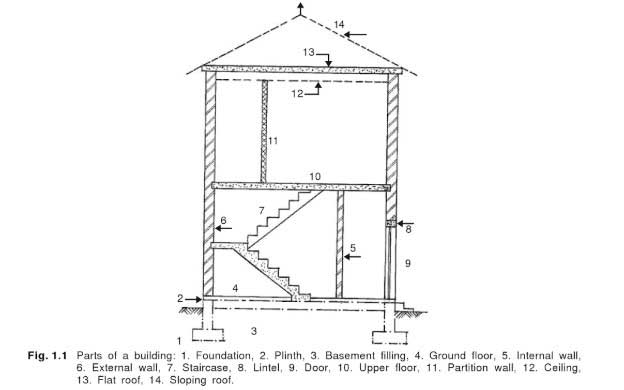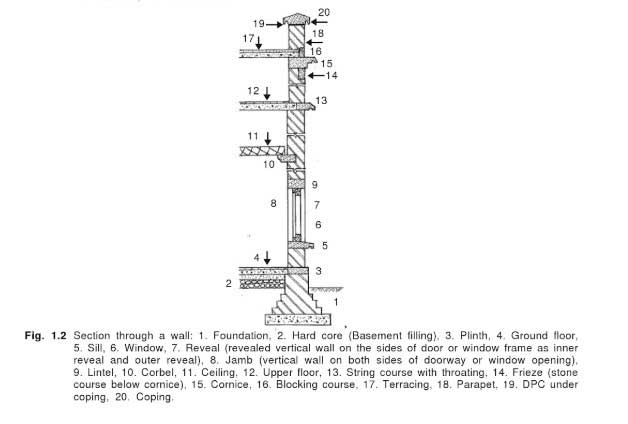So Let’s Start.
Components of a Building.
All buildings have the same components such as foundation, walls, floors, and roof.
In addition, we have to decorate them with plaster, paint, etc., to make them aesthetically beautiful.
These items of building works are called civil works.
Water and electricity have also to be supplied to the buildings to make them habitable.
These items are called building services.
In this article, we will briefly examine the various components of civil works and building services.
Parts of a Building: CIVIL WORKS.
The important parts of an ordinary building are shown in Figures 1.1 and 1.2.
They are as follows:
1. Foundation,
2. Plinth,
3. Walls and columns,
4. Floors,
5. Lintels and chajjas,
6. Roof,
7. Doors and windows,
8. Stairs and lifts,
9. Finishing work (plastering and painting),
10. Building services,
11. Fencing and external works.,
A building can be divided into substructure (foundation) and superstructure, the plinth level being the dividing line between them.
In building construction, we study how the civil works are carried out in the field after they have been planned by an architect and structurally designed by an engineer.
We should be aware that many aspects are involved in the preliminary planning and design of buildings.
For example, an architect specializes in the following works:
1. Planning the orientation, layout, and dimension of the rooms of the building
2. The preparation of the features to make the building attractive.
Work of this nature for small buildings may be taken by non-architects also.
However, the construction of a building should always be carried out under the supervision of a qualified person.
We will now briefly examine the construction of the different components of a building.
1. Foundation.
Foundation is a very important part of a building.
All the loads of superstructure are transmitted to the foundation.
A foundation engineer should know how to examine the soil profile and arrive at a suitable foundation.
The following are some of the different types of foundation generally used:
1. Strip foundation (shallow foundations)
2. Footing foundation (shallow foundations)
3. Raft foundation (shallow foundations)
4. Pile foundation (deep foundations)
5. Pier foundation (deep foundations).
In framed construction, we use footings as the foundation for the column and the brickwork for walls starts from grade beams connecting columns.
(Grade beams on under-reamed piles are also called capping beams).
2. Plinth
The plinth is a dividing line between the substructure and superstructure.
Thus, the projecting part of the wall above the ground level to the floor level is the plinth.
The plinth is usually kept at least 45 cm (1.5 ft) above the general ground level of the building.
3. Plinth Beam.
It is capped by a beam called plinth beam.
The provision of a plinth beam and damp-proof course at plinth level are very important in building construction.
4. Damp Proof Course (D.P.C).
The damp proof course is a layer provided in building to prevent the entering of dampness from the ground to the building components.
5. Walls and Columns.
Walls are mostly made of masonry.
It may be of brick, block-work, stonework, etc.
Buildings may also be constructed as a framed structure with columns and footings and
then Walled.
Most of the flats and high-rise buildings are built this way.
In many places in the masonry, we use arches and lintels.
6.Floors.
Floor is an important part of a building.
It is the place where the inhabitants perform their most activities.
It is constructed on the filling and laid over the plinth level.
Floors are usually made from different types of materials, such as, timber, brick, R.C.C.
Top floors are nowadays usually made of reinforced concrete.
7. Roof.
A roof is an important part of all buildings.
The most important item in housing is to have a “roof over one’s head.”
A roof is a layer which covers the structure from the top.
It also prevents the building and inhabitants from the ill effects of the environment.
Depending on the finances available and also the climatic conditions, we can have different kinds of roofs.
Roofs can be sloped or flat.
Many types of roofs and roofing materials are available nowadays.
8. Fabrication of Doors and Windows.
Openings are necessary in buildings for passages inside and outside the buildings.
We also need windows for lighting and ventilation.
A detailed study of doors and windows is an important part of building construction as the expenditure on this item alone can go up to 15 to 20 percent of the total cost of civil works.
Traditionally, doors and windows were made of wood and hence, this work is sometimes referred to as woodwork in buildings.
Other woodworks like provision of cupboards are also important, but it comes under the subject of interior decoration.
9. Stairs and Lifts.
Nowadays most buildings are made more than one storey high.
Which means there should be a way to go from one storey of the building to another.
Knowledge of various elements of a staircase and the construction of a simple staircase is essential to all those involved in building construction.
Study of the layout and design of ornamental staircases is a special subject.
Usually, vertical transportation devices like electric lifts are to be provided in buildings having more than four floors including the ground floor.
We must also be familiar with these devices.
10. Building Finishes.
The final appearance of a building depends very much on its finishing.
We have to deal with the following:
1. Plastering and pointing
2. Painting of walls, woodwork, grillwork, etc.
It is essential that we have a knowledge of the finishing to be used on the various materials of construction such as plaster, wood, metals, etc.
11. Building Services.
Water supply, drainage, sanitation, electric supply lifts, external works, construction of cupboard, etc. are considered as items outside of civil works and are called building services.
Water supply, drainage, and sanitation (building service).
These works are considered separate from civil works and are also estimated separately.
Design and details of these will be studied in public health engineering under building services.
However, an elementary treatment of the subject is always included in basic building construction.
Electrical works (building service).
Lighting and supply of electricity for various pieces of equipment used in buildings also come under building services.
The supply and distribution of electricity in a building is a specialized work to be carried out by an electrical engineer.
However, the basics of these works are also usually dealt with in elementary building construction.
Usually, a lump sum equal to 25 to 30 percent of civil works is estimated as the probable expense for the above two items taken together.
Read More: Cavity Wall Construction – its Advantages, Disadvantages.



such a valuable post. I am glad to know about the idea given in your post related CONSTRUCTion AS A FRAMED STRUCTURE WITH COLUMNS AND FOOTINGS.
It is necessary to know and examine the various components of civil works and building services. this is worth reading!
Thanks for sharing all of your experiences! I hope it would helps.
How about a BROKEN kitchen drain outside
damp inside kitchen wall
Pls what are the three most decorated parts of a building
Tnx much for this good equipped briefed u release liking it..??
Thanks for this post. It will go a long way to guide me in my expansion plan I’m embarking on in my house.
thank you for sharing this useful building tips and valuable information, i learned a lot reading it
This post is super informative! I really appreciate the breakdown of each component of a building. It’s interesting to see how everything fits together, and it makes me more aware of the structures around me. Great job!